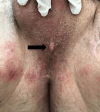Surgical strategies in artificial urinary sphincter revision surgery: troubleshooting the complications
- PMID: 39280650
- PMCID: PMC11399024
- DOI: 10.21037/tau-22-830
Surgical strategies in artificial urinary sphincter revision surgery: troubleshooting the complications
Abstract
Post-prostatectomy urinary incontinence (PPUI) is an important issue in the urological practice and imposes a negative effect on quality of life (QoL). Despite recent technological advances, PPUI remains a common complication and the artificial urinary sphincter (AUS) is regarded as the most effective long-term surgical treatment for moderate-to-severe stress urinary incontinence. Success rates for AUS as defined by a continence status of zero to one pad per day range from 59% to 90%. One potential downside of the AUS is the need for periodic revisions in a number of patients. Revision and explantation rates due to mechanical failure, urethral atrophy, infection and erosion vary considerably among studies with reports of 8-45% and 7-17%, respectively. These complications can be classified into different categories, including recurrent or refractory incontinence, erosion and/or infection, and other complications. This review article aims to describe the main AUS-related complications and their management strategies. Diagnostic work-up strategies are explored to facilitate timely identification and management of these complications. Additionally, emerging technologies and future directions in AUS development are discussed, highlighting potential advancements to mitigate complications and enhance device performance. This review consolidates current knowledge and provides insights for clinicians to manage the complexities associated with AUS therapy effectively.
Keywords: Post-prostatectomy; artificial urinary sphincter (AUS); urinary incontinence.
2024 Translational Andrology and Urology. All rights reserved.
Conflict of interest statement
Conflicts of Interest: Both authors have completed the ICMJE uniform disclosure form (available at https://tau.amegroups.com/article/view/10.21037/tau-22-830/coif). The series “50 Years Anniversary of the Modern Artificial Urinary Sphincter” was commissioned by the editorial office without any funding or sponsorship. M.A.A. is a member of the Coloplast Continence Advisory Board, and received fees from Medtronic (proctor for sacral neuromodulation) and from Boston Scientific (proctor for AMS800 implants). S.H.M.d.A is a member of the Coloplast Continence Advisory Board. The authors have no other conflicts of interest to declare.
Figures






Similar articles
-
Artificial urinary sphincters for male stress urinary incontinence: current perspectives.Med Devices (Auckl). 2016 Jul 4;9:175-83. doi: 10.2147/MDER.S93637. eCollection 2016. Med Devices (Auckl). 2016. PMID: 27445509 Free PMC article. Review.
-
Impact of previous urethroplasty on the outcome after artificial urinary sphincter implantation: a prospective evaluation.World J Urol. 2020 Jan;38(1):183-191. doi: 10.1007/s00345-019-02756-0. Epub 2019 Apr 12. World J Urol. 2020. PMID: 30980093
-
A User's Guide for Surgery Involving the Artificial Urinary Sphincter.Sex Med Rev. 2019 Jan;7(1):167-177. doi: 10.1016/j.sxmr.2018.10.004. Epub 2018 Dec 1. Sex Med Rev. 2019. PMID: 30509896 Review.
-
Continence and Complication Rates of Artificial Urinary Sphincter Devices (AMS 800) for Parkinson and Stroke Patients with Incontinence after Prostate Surgery: Retrospective Analysis of a Prospective Database.Urol Int. 2021;105(3-4):225-231. doi: 10.1159/000512051. Epub 2021 Jan 13. Urol Int. 2021. PMID: 33440398
-
A comparison of artificial urinary sphincter outcomes after primary implantation and first revision surgery.Asian J Urol. 2021 Jul;8(3):298-302. doi: 10.1016/j.ajur.2021.03.003. Epub 2021 Mar 13. Asian J Urol. 2021. PMID: 34401337 Free PMC article.
References
-
- Herschorn S, Boccon-Gibod L, Bosch JL, et al. Surgical treatment of urinary incontinence in men. In: Abrams P, Khoury S, Wein A, editors. First International Consultation on Urinary Incontinence. Plymouth, U.K.: Health Publications Ltd.; 1999:691-729.
Publication types
LinkOut - more resources
Full Text Sources
